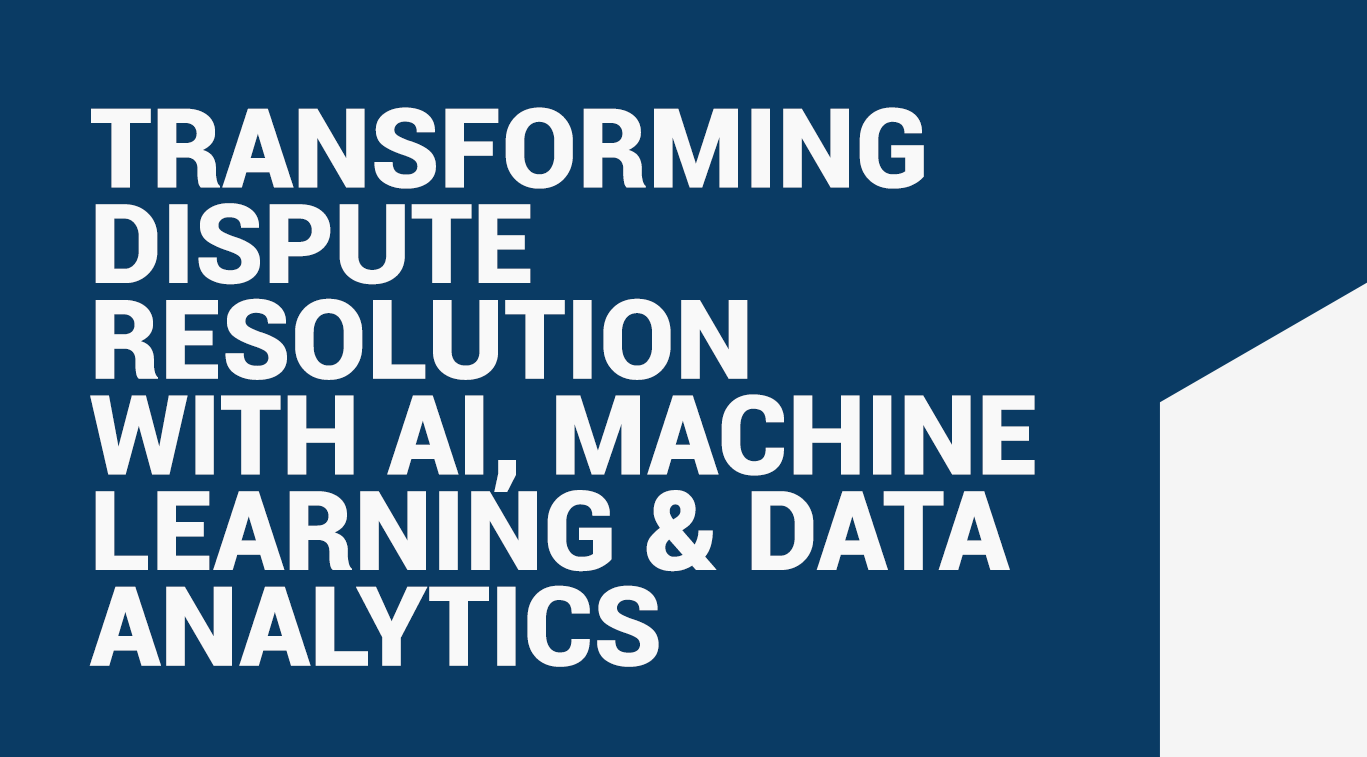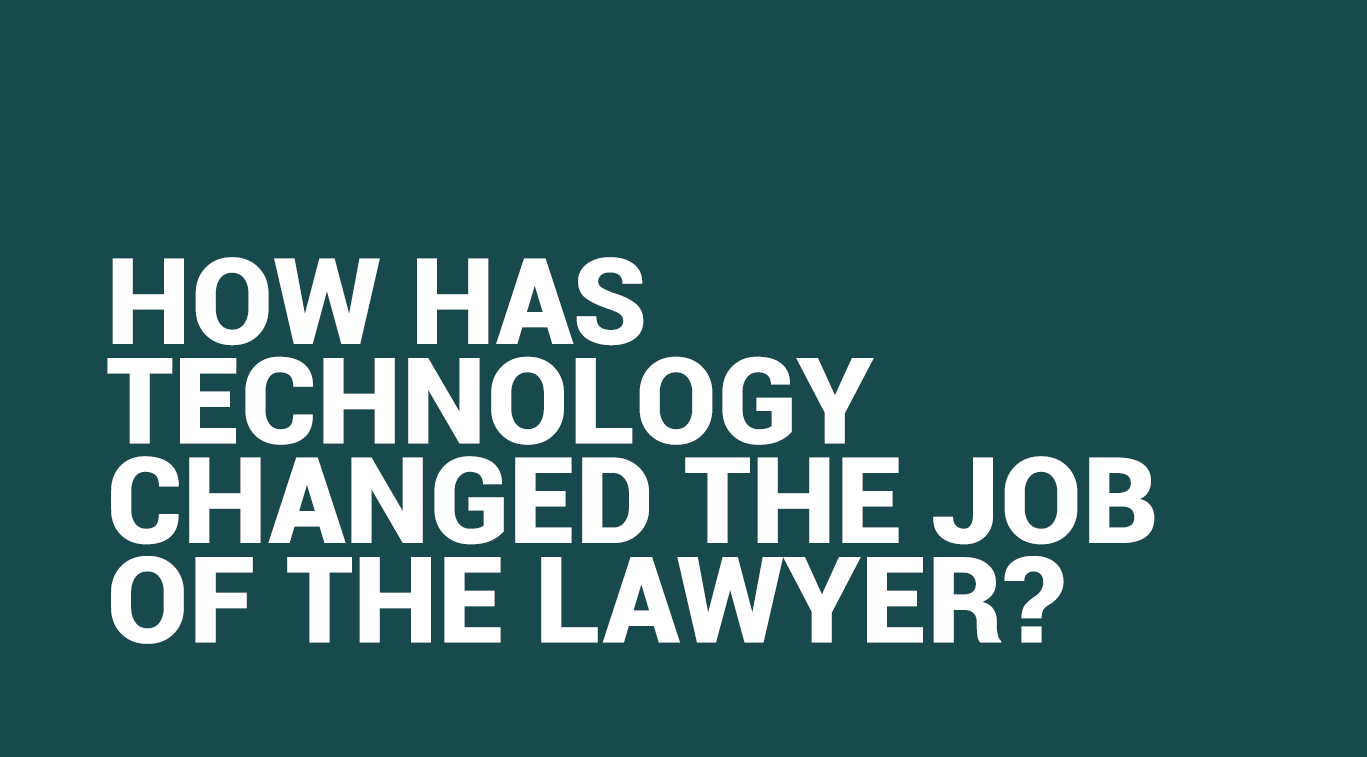Transforming Dispute Resolution With AI, Machine Learning & Data Analytics

Written by Maryam Khan
Blogger

New technologies are revolutionising how lawyers work and provide their legal services. Whether it is the integration of machine learning, optical character recognition, artificial intelligence or blockchain in the legal industry, new technologies are disrupting the legal sector by allowing law firms to process greater volumes of data and grow exponentially. Practice areas such as M&A, intellectual property and dispute resolution greatly benefit from being ‘digitalised’ through the use of smart contracts, predictive legal analytics, machine learning, litigation technology and data analytics to settle and resolve disputes.
The way dispute resolution works shares many similarities with the process of data analytics which involves the analysis of raw data to make conclusions, generate insights and discover trends. Dispute resolution can be described as a process of collecting, analysing, reviewing and presenting data to reach a conclusion. From the starting point of a claim, information is gathered and analysed to determine the facts of the case relevant to the dispute [1]. Once the facts are established, various case laws and statutory provisions are applied. Individuals involved in the dispute are then interviewed to gather more information and gain better insight into the case. Lawyers and arbitrators are then appointed based on their experience, background and credentials for each party. As the dispute develops, more documents are collected, shared and analysed, and more statutory provisions and case law are reviewed. The final result is a legal case based on factual data presented and submitted in writing to the tribunal. The tribunal then processes and analyses the data submitted and decides on the dispute [2].
While data analytics in dispute resolution is not new in the legal sector, it is becoming more popular following online disputes, virtual court hearings, e-filing in courts and the overall increase in electronic communication. This article will discuss the use of machine learning, data analytics and artificial intelligence in the legal sector to resolve disputes and the extent to which such tools are being integrated.
AI, Machine Learning & Data Analytics
Integrating artificial intelligence and data analytics in the legal sector has significantly cut costs and saved time for law firms when resolving a dispute. As law firms put in place more sophisticated mechanisms for collecting data from past arbitrations and trials, those tools will become increasingly effective when tailoring suggestions based on the client’s preferences and past experiences [3]. Artificial intelligence can elucidate how legal decisions are made and improve the consistency and predictability of court decisions [4].
Leading technology companies have previously developed predictive analytics tools which determine how courts will rule on a specific legal issue and have calculated the probability of winning a case [5]. Once the facts relevant to the case are identified, an algorithm situates the facts within the applicable legal jurisdiction and past precedents to predict the court’s decision if the pre-trial negotiation were to fail. This is a significant development for the legal industry as determining litigation outcomes play a crucial role in helping parties decide whether they should settle or go to court. In other words, it helps litigants identify their Best Alternative to a Negotiated Agreement (BATNA) [6].
Online Dispute Resolution (ODR)
Online dispute resolution helps resolve disputes and ensure cost-effectiveness and speed through artificial intelligence to streamline the dispute resolution process [7]. It involves using legal technology solutions to facilitate dispute resolution between parties through negotiation, mediation or arbitration [8]. Online dispute resolution gained popularity as it particularly advantaged those working internationally who could not attend hearings in person. The automated online process electronically delivers briefs and schedules video conference hearings for the convenience of parties separated geographically [9].
The branch of artificial intelligence involved in this case is machine learning. Here, the legal software is designed to identify patterns in data sets passed through it to generate and map outputs used to make judgments [10]. As more and more data gets passed through the system, more data is processed and trained, enabling the system to adapt its pattern mapping process and generate more outcomes. Once a system is completely trained, it can make predictions, spot inaccuracies and produce decisions [11].
Algorithmic Decision Making & Big Data
Algorithmic decision making based on data and statistical analysis is widely used by public bodies and across the legal sector. For example, algorithms are used to consider the eligibility for a benefit or a penalty, credit and insurance decisions and employment screening and sentencing within the criminal justice system [12].
The advanced legal solutions and statistical techniques powered by machine learning in these systems train data sets to improve their accuracy and fairness [13]. This process allows systems to discover patterns and anomalies in data without requiring the programmer to specify which factors to consider. Therefore, unexpected patterns and trends are discovered that the programmer or designer might not have known.
Although it can be argued that such a system may eliminate the risk of human bias when making decisions without involving algorithms and data analytics, there is always a risk of existing bias within the data being used to train the system, which results in the same biases being inadvertently reinforced by the system. There are also various other technical factors that could result in discriminatory decisions severely impacting people’s lives which will be discussed later in the article.
How Is This Impacting The Legal Sector?
Increased Efficiency
Incorporating artificial intelligence and big data allows smaller value claims to be dealt with more quickly. This frees up more court time to hear higher value and more complex cases and allows claimants to access an affordable means of obtaining an enforceable judgement, especially for straightforward cases [14]. For example, suppose an AI system predicts that a party has a low chance of winning the case in court based on previous decisions. In that case, the party is more inclined to settle the dispute. This saves time and money for the parties, the court and the lawyers involved.
Greater Access To Justice
The ability to analyse the likelihood of a case winning in court can reduce court backlogs and lead to greater access to justice [15]. Many people still do not consult lawyers or go to court due to the high legal fees associated with making a claim. However, as online dispute resolution and automated dispute resolution are more cost-effective, people will be more inclined to proceed with their claims through this avenue, especially when it comes to routine matters such as family, employment and landlord-tenant disputes.
Improved Risk Management
The use of artificial intelligence allows lawyers to make more accurate and better-informed decisions surrounding the potential risks in disputes in the future [16]. With so much historical data being processed, patterns within issues arising from previous cases can help legal counsel predict what risks a litigant is likely to experience when taking a claim forward. Having access to this information allows lawyers to better advise their clients by exploring the best routes to take given the predicted outcomes.
What Are The Challenges?
While AI in the legal profession is only being widely used in a few countries, such as China, Canada and the United Kingdom, it is still being used to assist judges in reaching conclusions and making decisions. However, the use of AI in reaching a decision is still under strict scrutiny as there is a risk of biases within the historical case law data used to train the system. This was the case with the Correctional Offender Management Profile for Alternative Sanctions (COMPAS), a risk-assessment tool used in the United States that determines the risk of a defendant committing another crime. The judges then consider this in deciding whether the court should grant bail or not [17]. Any biases incorporated into such systems can alter the outcome of a decision, which negatively impacts the defendants’ lives. Therefore, If these biases go undetected and unaddressed, it will defeat the purpose of incorporating legal technology in the first place to reduce inaccuracies and increase fairness within decision making [18].
Furthermore, incorporating artificial intelligence and data analytics is not recommended for every dispute. This especially applies to new legal issues or cases with no historical data or previous judgments to generate insights. Even in cases where there is enough historical data for processing, many further issues can arise. Although court judgments do follow a structure, they are quite different from one another, making it difficult to process, resulting in poorly constructed algorithms producing inaccurate predictions. This applies to all types of unstructured data used for processing ranging from email communications, documents and letters [19]. Moreover, the process of transforming unstructured legal data to structured data involves a complex research-intensive process that can be costly as it involves a team of skilled researchers.
Lastly, one of the key issues with automated decision making, especially within court judgments, is that they provide little to no reasoning behind how a decision was made and what factors were considered. This can result in issues with transparency and further doubts regarding built-in biases within the software.
The Future of AI in Dispute Resolution
There is a growing trend of people resorting to out-of-court settlements to resolve their disputes to save time and money. Following this trend, artificial intelligence-powered tools are increasingly used to determine pre-trial strategies that can be critical for the outcome of a trial. Advanced legal software can now predict how a particular judge may rule on a case based on their previous rulings or even which argument may persuade a particular judge best. Such developments highlight the importance of leveraging insights and shed light on many concerns during the process, such as discrimination, profiling and issues with reliability. Automated decision making is currently only used to settle straightforward cases as there is still more work to be done to tackle complex high-value ones. There is great room for improvement in tackling bias, processing unstructured data and providing greater transparency.
References
[1] Charlie Morgan & Rebecca Reed, ‘Dispute Resolution In The Era of Big Date And AI’, Herbert Smith Freehills Legal Briefings (2019) at https://www.herbertsmithfreehills.com/insight/dispute-resolution-in-the-era-of-big-data-and-ai
[2] Ibid
[3] Ibid
[4] R. Guimerà and M. Sales-Pardo, “Justice Blocks and Predictability of U.S. Supreme Court Votes” (2011), Plos One at https://journals.plos.org/plosone/article?id=10.1371/journal.pone.0027188
[5] Maxime Cohen, ‘Conflict Analytics: When Data Science Meets Dispute Resolution’, Desauntels Faculty of Management, McGill University at https://maxccohen.github.io/Conflict-Analytics-MBR.pdf
[6] R. Fisher et al., “Getting to Yes: Negotiating Agreement without Giving In” (Houghton Mifflin Harcourt 1991) at https://digitalcommons.usu.edu/unf_research/47/
[7] Adesina Temitayo Bello, ‘Online Dispute Resolution Algorithm: The Artificial Intelligence Model as a Pinnacle’ Kluwer Online (2018) at https://kluwerlawonline.com/journalarticle/Arbitration:+The+International+Journal+of+Arbitration,+Medi
ation+and+Dispute+Management/84.2/AMDM2018033#:~:text=Online%20dispute%20resolution%20(O
DR)%20can,based%20on%20information%20and%20connection.
[8] Jeremy Barnett & Philip Treleaven, ‘Algorithmic Dispute Resolution – The Automation of Professional Dispute Resolution Using AI and Blockchain Technologies’, The Computer Journal, Volume 61, Issue 3 (2018) at https://academic.oup.com/comjnl/article/61/3/399/4608879
[9] Ibid
[10] Osborne Clarke, ‘AI and The Future Of Dispute Resolution: Computer Says No?’ Insights (2021) at https://www.osborneclarke.com/insights/ai-future-dispute-resolution-computer-says-no
[11] Ibid
[12] Marc MacCarthy, ‘Fairness In Algorithmic Decision-Making’ Brookings Report (2019) at https://www.brookings.edu/research/fairness-in-algorithmic-decision-making/
[13] Ibid
[14] Ibid
[15] Bryan Jung, ‘Will AI Transform Disputes As We Know It?’, Thomson Reuters (2021) at https://insight.thomsonreuters.com.au/legal/posts/will-ai-transform-dispute-resolution-as-we-know-it
[16] Ibid
[17] Ibid
[18] Ibid (12)
[19] Ibid (5)








